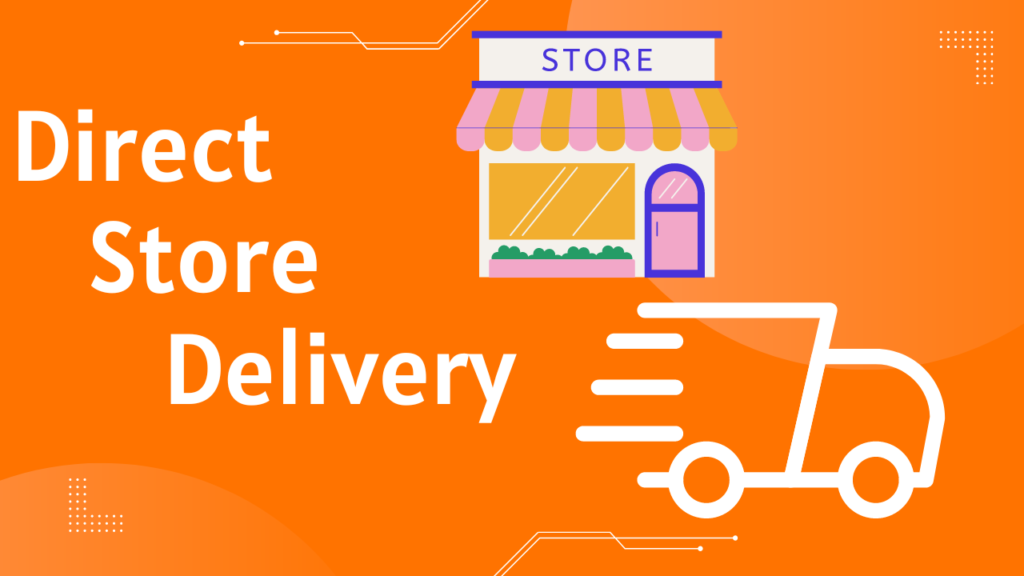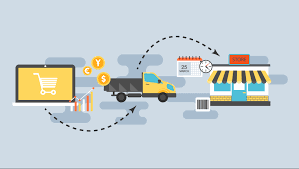A direct store delivery guide is a resource that provides information and guidance on the processes, strategies, and best practices involved in implementing a direct store delivery model for supply chain management. It aims to help manufacturers, suppliers, and retailers optimize their operations by streamlining the delivery process and improving inventory management, while also enhancing the customer experience
What is direct store delivery?

Direct store delivery refers to a type of supply chain arrangement in which manufacturers or suppliers transport their products directly to retail stores or locations, bypassing centralized warehouses or distribution
Direct store delivery (DSD) is a method of supply chain management in which manufacturers or distributors deliver products directly to retail stores, rather than using a centralized warehouse or distribution center as an intermediary. This approach allows for more efficient and timely delivery of goods to stores, reducing the time and costs associated with shipping and warehousing.
Under the DSD model, suppliers maintain direct control over inventory and are responsible for restocking store shelves with their products. This allows for greater flexibility and responsiveness to changing consumer demand, as well as more direct communication and collaboration between suppliers and retailers.
DSD is commonly used in industries such as food and beverage, consumer packaged goods, and pharmaceuticals, where freshness, quality, and speed of delivery are critical to maintaining customer satisfaction and loyalty.
Benefits of direct store delivery

Direct store delivery (DSD) is a method of delivering goods from a supplier or manufacturer directly to a retail store or other point of sale, bypassing the distribution center or warehouse. Here are some benefits of direct store delivery:
1.increased control
Direct Store Delivery (DSD) offers several benefits to manufacturers or suppliers, including greater control over the delivery process and more direct communication with retailers. By utilizing DSD, manufacturers or suppliers can bypass distribution centers and deliver products directly to retailers, ensuring that they are delivered on time and in good condition.
This direct delivery method allows for more effective communication between manufacturers or suppliers and retailers. It enables both parties to collaborate more closely, exchange information about inventory levels, and adjust orders based on real-time data. This improved communication can help prevent stockouts and reduce the risk of overstocking, leading to more efficient inventory management
2.fresher products
Direct Store Delivery (DSD) can provide significant benefits for delivering fresher products. By utilizing DSD, manufacturers or suppliers can deliver their products directly to retailers, bypassing distribution centers and warehouses, resulting in a shorter supply chain.
This shorter supply chain can help ensure that products are fresher when they reach the retailer. For perishable products like produce, dairy, or baked goods, this is particularly important. By delivering products directly to stores, manufacturers or suppliers can better manage the product’s freshness, ensuring that it is properly handled and stored during transport.
3.improved inventory
Direct Store Delivery (DSD) can provide retailers with valuable real-time information on product availability and demand, allowing them to better manage their inventory levels. This improved inventory management can help reduce waste and avoid out-of-stock situations, leading to a more efficient and effective supply chain.
By utilizing DSD, manufacturers or suppliers can deliver products directly to retailers, bypassing distribution centers and warehouses. This direct delivery method allows for more effective communication between manufacturers or suppliers and retailers, enabling both parties to collaborate more closely and exchange information about inventory levels.
This real-time information on product availability and demand can help retailers make informed decisions about inventory management. Retailers can adjust their inventory levels based on demand, ensuring that they have enough stock to meet customer needs without overstocking. This can help reduce waste and avoid out-of-stock situations, which can lead to lost sales and decreased customer satisfaction.
4.faster restocking
Direct Store Delivery (DSD) can provide retailers with faster and more frequent product deliveries, leading to more efficient restocking and ultimately improving customer satisfaction and increasing sales.
By utilizing DSD, manufacturers or suppliers can deliver products directly to retailers, bypassing distribution centers and warehouses. This direct delivery method can enable retailers to receive product deliveries more frequently and quickly, reducing the time it takes to restock shelves.
With more frequent and faster deliveries, retailers can respond more quickly to changes in demand and avoid out-of-stock situations. This can improve customer satisfaction, as customers are more likely to find the products they are looking for in stock. Additionally, retailers can optimize their shelf space by stocking the right products at the right time, leading to increased sales and profits.
5.increased sales
DSD can help to increase sales by providing retailers with a wider range of products and more frequent deliveries. This can also help to reduce the amount of time and money spent on inventory management, allowing retailers to focus on other areas of their business.
6. Increases customer satisfaction
Putting customers first is a crucial strategy for any business looking to succeed in a competitive market. By ensuring faster and sufficient stocking at retail stores, businesses can reduce the incidence of stockouts and improve customer satisfaction. This not only helps customers find the products they want quickly but also enhances their overall experience, leading to a more loyal customer base.
In addition to efficient stocking and inventory management, businesses can adopt other customer-centric strategies such as providing personalized marketing, exceptional customer service, and streamlined checkout processes. By prioritizing the needs of the customer, businesses can build a strong and loyal customer base, leading to sustained success in the long run
7. Long-lasting relationship with customers
Establishing a direct delivery method between a brand and retailers can lead to a stronger relationship with the end customers. This allows brands to gain market insights, such as which products are in high demand, current market trends, and which products are not performing well. Armed with this information, brands can communicate more effectively and develop effective sales strategies to improve customer service and drive business success.
However, it’s important to acknowledge that benefits and challenges coexist in any business endeavor. While direct delivery methods can strengthen brand-retailer associations, they can also lead to increased costs and logistical complexities. Additionally, implementing a new distribution strategy may require significant investment in technology and training, which can be a challenge for some businesses.
Overall, direct store delivery can be a beneficial method of delivering goods for both manufacturers and retailers, as it can help to improve efficiency, increase sales, and provide fresher and higher quality products for consumers.
Also,it’s important to know the difference between Shipping & Delivery
What are the Challenges of Direct Store Delivery?
Direct store delivery (DSD) can offer numerous benefits to manufacturers, suppliers, and retailers, but it also comes with several challenges. Here are some of the challenges of direct store delivery:
1.cost
Yes, the cost of DSD can be a significant challenge for smaller manufacturers or suppliers. This is because DSD requires dedicated delivery teams and vehicles to transport products directly from the manufacturer or supplier to the retail store or point of sale. The cost of maintaining these teams and vehicles can be high, particularly for smaller manufacturers or suppliers who may not have the resources to invest in their own delivery infrastructure.
In addition to the cost of maintaining delivery teams and vehicles, there may also be other costs associated with DSD, such as marketing and advertising expenses to promote the products at the point of sale, and the cost of managing inventory and tracking sales data.
2.complex logistics
the logistics process involved in DSD can be more complex than other distribution methods, and this can pose challenges for manufacturers, suppliers, and retailers. One of the main challenges is the need for real-time inventory management and demand forecasting. With DSD, products are delivered directly from the manufacturer or supplier to the retailer, so it’s crucial to have accurate information on inventory levels and product demand to avoid stockouts or overstocking.
Additionally, DSD requires coordination between the manufacturer or supplier, the delivery team, and the retailer to ensure that products are delivered on time and in the right condition. This coordination can be difficult to achieve, especially if there are communication issues or delays in the delivery process.
3.limited geographic reach
limited geographic reach of DSD can be a challenge for manufacturers and suppliers who are looking to expand their market. DSD requires dedicated delivery teams and vehicles to transport products directly from the manufacturer or supplier to the retail store or point of sale. As a result, the reach of DSD is often limited to a specific geographic area where the manufacturer or supplier has established a delivery infrastructure.
This limitation can make it difficult for manufacturers or suppliers to expand their market beyond their existing delivery area, which can impact their growth potential. Additionally, if a manufacturer or supplier has to rely on a third-party logistics provider (3PL) to handle DSD deliveries, they may not have control over the geographic reach of their distribution network.
4.increased cometiton
increased use of DSD has led to more competition between manufacturers and suppliers, which can create pressure to lower prices or increase product quality to remain competitive. As DSD has become more widespread, more manufacturers and suppliers are using this distribution method to deliver their products directly to retailers, which has led to increased competition in the marketplace.
One of the key factors driving this competition is the ability of DSD to provide fresher products, better inventory management, and faster restocking for retailers. As a result, manufacturers and suppliers must compete on the quality of their products, delivery times, and pricing to remain competitive.
5.dependence on delivery teams
manufacturers and suppliers who use DSD rely on their delivery teams to represent their brand and ensure that products are delivered on time and in good condition. This can be a challenge if the delivery team is not well-trained or if there is high turnover.
The delivery team is often the face of the manufacturer or supplier to the retailer, and they play a crucial role in building and maintaining the relationship between the manufacturer or supplier and the retailer. If the delivery team is not well-trained, they may not be able to provide the level of service that the retailer expects, which can damage the relationship between the manufacturer or supplier and the retailer.
6. Lack of proper communication
The lack of proper communication can have a significant impact on the success of any business. In the case of Direct Store Delivery (DSD), it can be challenging to connect the dots between the brands (suppliers), distribution center staff, and the retailer. This can result in a lack of coordination on delivery status, product inventory, and pricing changes, which can ultimately impact the profit margin of the company.
When there is a lack of proper communication, it can lead to delays in delivery, misunderstandings about inventory levels, and incorrect pricing information. This can result in lost sales, decreased customer satisfaction, and reduced profit margins for all parties involved.
To address this challenge, it is essential to establish clear communication channels between all stakeholders involved in the DSD process. Manufacturers or suppliers, distribution center staff, and retailers should communicate regularly to ensure that everyone is on the same page regarding delivery schedules, inventory levels, and pricing information.
